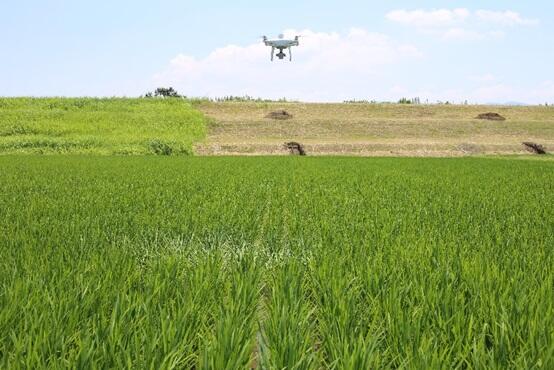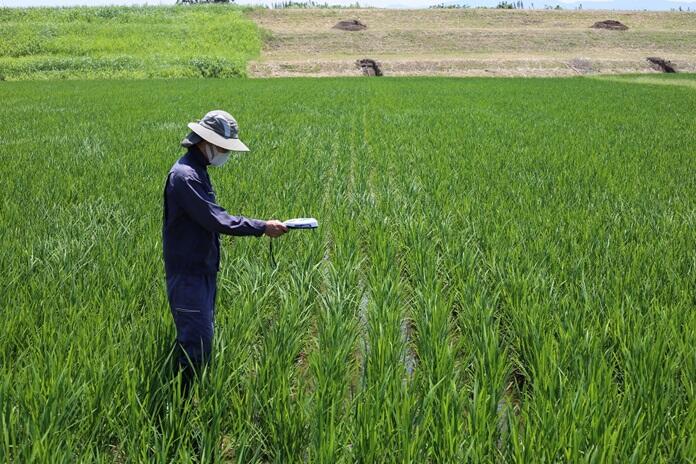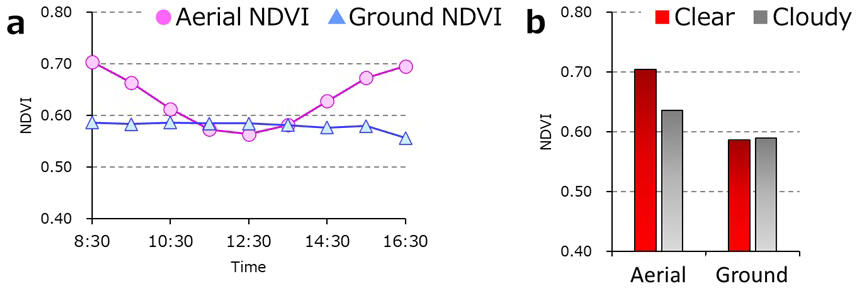A research group led by Hiroshi Nakano, Deputy Leader of the Smart Lowland Crop Rotation Group at the Kyushu‐Okinawa Agricultural Research Center, NARO (currently Senior Researcher of the Division of Crop Rotation Research for Lowland farming at the Central Region Agricultural Research Center (Kanto, Tokai and Hokuriku Regions), NARO), announced the development of a novel system that calculates the amount of required fertilizer through growth diagnosis. To correct the extensive NDVI measurement data for paddy fields, obtained by drones, the system obtains the same data from several ground locations. The research group developed formulas for calculating the amount of fertilizer for "Koshihikari," the most widely grown variety of rice in Japan, and "Hinohikari," the main variety in western Japan. They aim to expand the application of these formulas to other rice varieties in the future.
The system overcomes the challenges encountered in conventional drone measurements. This achievement is expected to contribute to paddy rice cultivation by large‐scale producers and private companies, leading to increased efficiency, as well as stable yield and quality. The report was published in the international journal "Crop and Environment".

Provided by NARO
The yield and quality of rice have been destabilized in recent years due to the impact of abnormal weather patterns and climate change, and there is growing concern about further declines in yield and quality in the future. In Japan, with the aging of agricultural workers, there is a trend toward consolidation of farmland and large‐scale management by corporations. Therefore, it is expected that technologies for the efficient management of large‐scale fields will be developed.
Nitrogen is an important fertilizer component in paddy rice cultivation. When topdressing nitrogen around 20 d before heading until the heading stage, the amount of nitrogen is positively correlated with a decrease in malformed grains, which affects both the increase in the yield and market price. However, excess nitrogen could lead to lodging and reduced taste quality. This means that it is necessary to apply an appropriate amount of nitrogen.
Previously, the amount of required nitrogen fertilizer was estimated through growth diagnosis based on measurements such as the normalized difference vegetation index (NDVI) taken on the ground. This method required acquiring data for each paddy field using a portable NDVI measurement device, which imposed significant labor on the operators.
Instead of measurements conducted by operators, drone‐based growth diagnosis is expected. However, there is a difference between aerial NDVI measurements (aerial NDVI), which measure the light reflected from sunlight by plants, and ground‐based NDVI measurements (ground NDVI), which measure the light reflected from the measurement device by plants. Due to this difference, aerial NDVI cannot be used for growth diagnosis.

Provided by NARO
In this study, the research group aimed to improve the accuracy of the measurement by correcting the aerial NDVI, and to use this technique for growth diagnosis. First, when examining the relationship between aerial and ground NDVI, measurement time, and weather, they found that the aerial NDVI was significantly influenced by the solar altitude and weather. In 2020 and 2021, when examining the correlation between the yield and both aerial and ground NDVI, they found a higher correlation with ground NDVI.
The correlation increased when the aerial NDVI was corrected with ground NDVI at several locations, confirming the practical feasibility. Increasing the number of measurement locations for ground NDVI (used for correction) further enhanced the correlation.
When targeting the yield, it is necessary to capture aerial images of all the fields for growth diagnosis using drones equipped with multispectral cameras in the developed system, approximately 1 to 4 weeks before heading, and obtain aerial NDVI using image analysis software. Simultaneously, the ground NDVI is measured in areas with good growth, areas with poor growth, and areas with intermediate growth (approximately 3 locations).
Increasing the number of measurement locations for ground NDVI can improve the accuracy. However, considering factors such as the travel time for measurements, it is reasonable to have around three measurement locations. Additionally, it is necessary to determine the regression equation from the correlation between the aerial NDVI and ground NDVI and correct the aerial NDVI by comparison with the ground NVDI for all the fields. To determine the amount of required fertilizer, it is also necessary to substitute the target yield and corrected NDVI into the formula (prepared in advance for each growth stage) for calculating the fertilizer amount.
In the field demonstration conducted in Saga Prefecture in 2021, the amount of required fertilizer determined by correcting the aerial NDVI against the ground NDVI was 3.5 kg/10a. This value was very close to the ground NDVI (3.4), achieving an actual yield of 592±13 kg/10a (within the target yield range of ±5%). Similar results were obtained in the field demonstration in 2022, effectively preventing lodging and other crop damage in paddy fields. The amount of required fertilizer calculated using only the aerial NDVI was 16.7 kg/10a.

Provided by NARO
Other organizations, such as private companies, can utilize the developed system through programs created in Excel provided by NARO. NARO developed standards and functions aimed at improving convenience. By installing them on servers, the organizations can access and utilize these standards and functions in their own farm management systems via the agricultural data integration platform.
Currently, formulas for calculating the amount of required fertilizer are provided for two varieties, "Koshihikari" and "Hinohikari," covering approximately 40% of the total paddy cultivation area in Japan. In the future, it is expected that public experimental and research institutions in each prefecture, along with other organizations, will cooperate to cover other rice varieties, leading to improved convenience.
Nakano stated, "In addition to calculating the required fertilizer amount, we plan to develop a technology that accurately detects weeds and pests on the ground. Similar to the current technology, we can correct the aerial data to assess the extent of damage, determine the timing of pesticide spraying, and even decide whether or not spraying is necessary. Additionally, we are working on developing a formula for calculating the appropriate amount of fertilizer for wheat crops."
This article has been translated by JST with permission from The Science News Ltd. (https://sci-news.co.jp/). Unauthorized reproduction of the article and photographs is prohibited.




